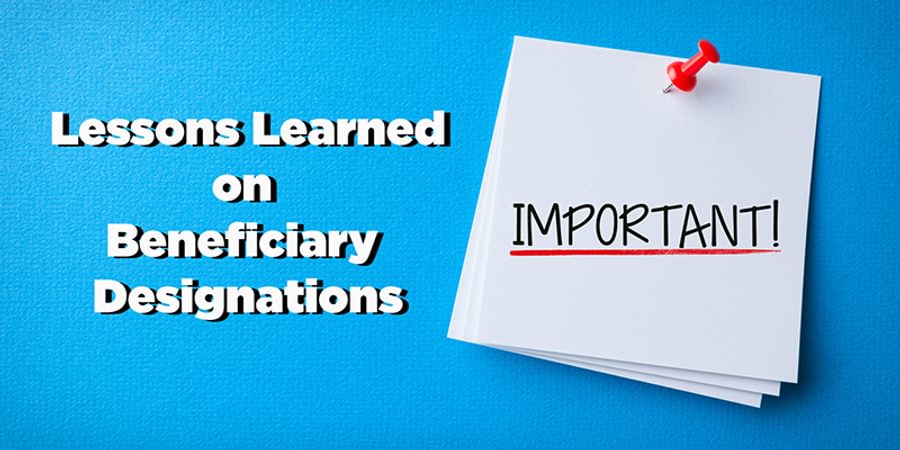
The importance of reviewing all beneficiary designations is best told by actual stories of beneficiary designations gone bad. We asked those who handle corporate retirement plans, and particularly the processing of beneficiary claims, about beneficiary designations gone bad. Here's what they shared about bad situations left behind for unsuspecting heirs to navigate.
The importance of reviewing all beneficiary designations is best told by actual stories of beneficiary designations gone bad. As the director of Retirement Plan Services, I reached out to third party administrators, whose work relates to corporate retirement plans and includes the processing of beneficiary claims, and asked them to provide examples of beneficiary designations gone bad that they have witnessed. What follows is a collection of a few said stories that left a mess for heirs to navigate.
Don’t Let This Be You!
The names are made up, but the stories are real. Learn from these mistakes so that your story does not become fodder for a blog entry like this!
- George M. Bearest and his ex-wife went through an ugly divorce. All assets were divided per the Qualified Domestic Relations Order, and everyone in the family moved on with their lives. Among the assets divided was George’s sizable 401(k) balance. [Fast forward 15 years.] George’s daughter, Vera O. Ganiszt asked him if he ever changed his beneficiary information on his work retirement plan, which was prompted because she had recently updated hers due to a life change. Lo and behold, George’s ex- was still the named beneficiary, and no waiver/automatic removal of a former spouse was in place in the plan. Had George passed away during those 15 years, his ex- would have received 100% of his retirement account, and his children, who were beneficiaries on all of his other accounts would have received nothing from that sizeable portion of his estate.
- Dr. Dewey Healer, a career medical doctor, passed away, leaving a sizable retirement account behind. When his surviving spouse, Wendy U. Healer, contacted the plan administrator to roll the account into her IRA, much to her chagrin, she learned that Dr. Healer’s former spouse, Wanda-Sue Healer, was still his beneficiary on the account. Doc and Wendy had been married for over 20 years, and Doc simply assumed that the current spouse was automatically the beneficiary. The plan administrator was required to distribute the funds to Wanda-Sue, the named beneficiary, and Wendy, the current spouse, had to fight the former spouse in civil court to try to claim the funds.
- Polly Gonn has three children from a first marriage and remarried later in life. Prior to their marriage, she talked to Doug about wanting her children to remain the beneficiaries of her 401(k) plan balance. Doug agreed to the request and signed off on the updated beneficiary form shortly after their marriage. However, the form never was returned to the participant’s employer and, therefore, was never updated. The terms of the plan automatically designates a spouse as the primary beneficiary in the event of marriage as a default. Unfortunately, Polly passed away suddenly, and her children reach out to claim their deceased mother’s account, knowing that mom stated that they were to inherit that account. Because the paperwork was never properly filed, Doug had to take the funds himself. Desiring to still honor Polly’s intentions, he did gift the proceeds to Polly’s children, so that was silver lining for them. However, all the taxes had to be paid on that distribution to pull that off in one tax year, and the distributed assets were no longer invested on a tax-deferred basis thereafter. That said, had Doug decided not to carry out Polly’s wishes, the children would not have received any of the funds.
- Lou Skanon, a 401(k) participant, was not divorced but separated from his wife (and I don’t mean legally separated). He was living with another women and died unexpectedly. His girlfriend with whom he was living at the time of his death had been named the beneficiary on his life insurance policy. Apparently, life insurance has different beneficiary rules than qualified plans, at least in some states (dependent upon whether the state is a community property state or an equitable distribution state). The girlfriend assumed that she was also the beneficiary on Lou’s 401(k) plan and called the plan sponsor, creating quite a stir. The administrator ended up processing the inherited account to the estranged wife as his beneficiary on the 401(k), but Lou’s girlfriend remained as the beneficiary on the life insurance policy.
The Bottom Line
It is a bad idea to assume that if you change your beneficiary in one place, it applies to all benefits. Make sure all accounts and policies are named according to your wishes, even if the need to change them was decades in the past.
These stories illustrate the importance of reviewing and updating all beneficiary designations. Assets with beneficiary designations (life insurance, qualified plans such as 401(k)s or 403(b)s, and all IRA accounts) will be disseminated to named heirs by whatever official beneficiary designations were on file at the time of death by each individual account/benefit. Note, as well, that an updated will is not sufficient and does not override beneficiary designations.
If you have questions about beneficiary designations, we invite you to contact any of McKinley Carter's Advisory Team members.
